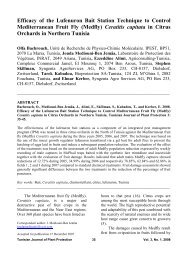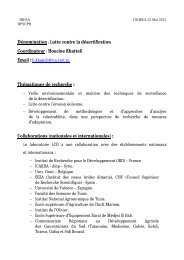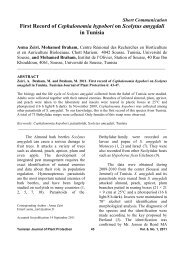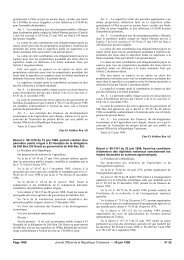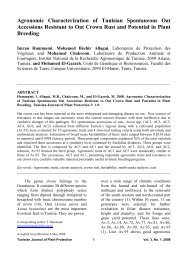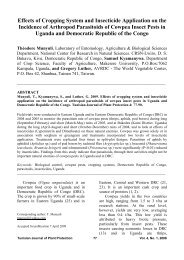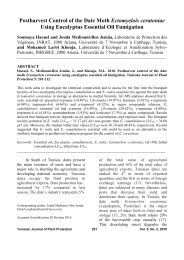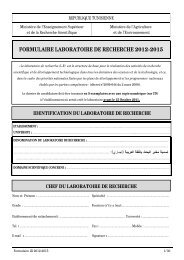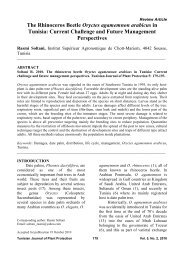Seasonal Abundance Patterns of Insects and Mites on Pear ... - Iresa
Seasonal Abundance Patterns of Insects and Mites on Pear ... - Iresa
Seasonal Abundance Patterns of Insects and Mites on Pear ... - Iresa
Create successful ePaper yourself
Turn your PDF publications into a flip-book with our unique Google optimized e-Paper software.
The thrips, Thrips tabaci (Thripidae),<br />
was also recorded, especially <strong>on</strong> leaves,<br />
fruits <str<strong>on</strong>g>and</str<strong>on</strong>g> insignificantly <strong>on</strong> flowers.<br />
<strong>Pear</strong> fruits were infested with the fruit<br />
fly Ceratitis capitata (Trypetidae). The<br />
termite species Anacanthotermes<br />
ochraceus (Hodotermitidae) was<br />
infrequently observed <strong>on</strong> the wood, in<br />
some samples.<br />
The flat scarlet mite, Cenopalpus<br />
pulcher (Tenuipalpidae), was a comm<strong>on</strong><br />
pest <strong>on</strong> pear trees during all period <str<strong>on</strong>g>of</str<strong>on</strong>g><br />
study. The mature, immature stages <str<strong>on</strong>g>and</str<strong>on</strong>g><br />
eggs were observed <strong>on</strong> the wood, buds <str<strong>on</strong>g>and</str<strong>on</strong>g><br />
leaves <str<strong>on</strong>g>and</str<strong>on</strong>g> scarcely <strong>on</strong> fruits. Another mite<br />
species, Tetranychus urticae<br />
(Tetranychidae), was also recorded <strong>on</strong><br />
leaves. Some pest species were recorded<br />
infrequently, i.e., the scale insect<br />
Lepidosaphes ulmi (Diaspididae), the<br />
thrips Retithrips syriacus (Thripidae), the<br />
s<str<strong>on</strong>g>of</str<strong>on</strong>g>t scale insect Coccus hespridum<br />
(Coccidae), in additi<strong>on</strong> to mite species as<br />
Tydeus californicus (Tydeidae) <str<strong>on</strong>g>and</str<strong>on</strong>g> pear<br />
mite Eriophes pyri (Eriophyidae).<br />
It is noteworthy to menti<strong>on</strong> that<br />
various natural enemies were also recorded<br />
during investigati<strong>on</strong> for instance, larvae<br />
<str<strong>on</strong>g>and</str<strong>on</strong>g> eggs <str<strong>on</strong>g>of</str<strong>on</strong>g> Chrysoperla carnae,<br />
coccinellid larvae, syrphid larvae <str<strong>on</strong>g>and</str<strong>on</strong>g><br />
nymphs <str<strong>on</strong>g>of</str<strong>on</strong>g> predacious thrips. Moreover,<br />
some species <str<strong>on</strong>g>of</str<strong>on</strong>g> predacious mites were<br />
found such as Cunaxa sp. (Cunaxidae),<br />
Cheyletogenus ornatus (Cheyletidae) <str<strong>on</strong>g>and</str<strong>on</strong>g><br />
Amblyseus sp. (Phytoseidae).<br />
Populati<strong>on</strong> dynamics <str<strong>on</strong>g>of</str<strong>on</strong>g> insect <str<strong>on</strong>g>and</str<strong>on</strong>g><br />
mite pests. The populati<strong>on</strong> dynamic <str<strong>on</strong>g>of</str<strong>on</strong>g><br />
different pests attacking pear trees during<br />
the blooming period at new <str<strong>on</strong>g>and</str<strong>on</strong>g> old<br />
experimental orchards in seas<strong>on</strong> 2005 are<br />
shown in Fig. 1. The pests reached their<br />
maximum populati<strong>on</strong>s in the sec<strong>on</strong>d<br />
decade <str<strong>on</strong>g>of</str<strong>on</strong>g> May when the average <str<strong>on</strong>g>of</str<strong>on</strong>g><br />
temperature <str<strong>on</strong>g>and</str<strong>on</strong>g> relative humidity were<br />
25ºC <str<strong>on</strong>g>and</str<strong>on</strong>g> 50.5 % RH, respectively. The<br />
results showed that the most abundant pest<br />
species were the scale insects, followed by<br />
mites then aphid, mealybugs, leaf hopper,<br />
thrips <str<strong>on</strong>g>and</str<strong>on</strong>g> psylla in the new orchard.<br />
However, in the old orchards the most<br />
dominant species were mites followed by<br />
the mealybugs after that, thrips, scale<br />
insects, leaf hopper <str<strong>on</strong>g>and</str<strong>on</strong>g> aphid, whereas the<br />
psyllid was not recorded in this locati<strong>on</strong>.<br />
In the new orchard, scale insects were<br />
observed in low numbers (with an average<br />
<str<strong>on</strong>g>of</str<strong>on</strong>g> 0.24 individual) <strong>on</strong> pear trees from the<br />
beginning <str<strong>on</strong>g>of</str<strong>on</strong>g> the survey (March 1, 2005)<br />
<str<strong>on</strong>g>and</str<strong>on</strong>g> increased gradually to reach its peak<br />
(7.37 individuals) during the sec<strong>on</strong>d<br />
decade <str<strong>on</strong>g>of</str<strong>on</strong>g> May. The mite populati<strong>on</strong>s<br />
showed two peaks; the first (1.57<br />
individuals) during the sec<strong>on</strong>d decade <str<strong>on</strong>g>of</str<strong>on</strong>g><br />
April at 23.5ºC <str<strong>on</strong>g>and</str<strong>on</strong>g> 50% RH <str<strong>on</strong>g>and</str<strong>on</strong>g> the<br />
sec<strong>on</strong>d (3.78 individuals) in the sec<strong>on</strong>d<br />
decade <str<strong>on</strong>g>of</str<strong>on</strong>g> May at 25ºC <str<strong>on</strong>g>and</str<strong>on</strong>g> 50.5 % RH.<br />
The dynamic <str<strong>on</strong>g>of</str<strong>on</strong>g> aphid populati<strong>on</strong> was<br />
initiated (with an average <str<strong>on</strong>g>of</str<strong>on</strong>g> 0.28<br />
individuals) during the first decade <str<strong>on</strong>g>of</str<strong>on</strong>g><br />
April at 18.5ºC <str<strong>on</strong>g>and</str<strong>on</strong>g> 54.5 % RH to reach its<br />
peak (2.56 individuals) in the sec<strong>on</strong>d<br />
decade <str<strong>on</strong>g>of</str<strong>on</strong>g> May. Mealybugs were recorded<br />
with an average <str<strong>on</strong>g>of</str<strong>on</strong>g> 0.29 individuals in the<br />
sec<strong>on</strong>d decade <str<strong>on</strong>g>of</str<strong>on</strong>g> March at 14.8.5ºC <str<strong>on</strong>g>and</str<strong>on</strong>g><br />
55.5 % RH which decreased gradually to<br />
zero in the first <str<strong>on</strong>g>of</str<strong>on</strong>g> April, then to occur<br />
back to attain the maximum <str<strong>on</strong>g>of</str<strong>on</strong>g> 1.08<br />
individuals in the sec<strong>on</strong>d decade <str<strong>on</strong>g>of</str<strong>on</strong>g> May,<br />
2005. The dynamics <str<strong>on</strong>g>of</str<strong>on</strong>g> leaf hopper, thrips<br />
<str<strong>on</strong>g>and</str<strong>on</strong>g> psylla were slight <str<strong>on</strong>g>and</str<strong>on</strong>g> not c<strong>on</strong>stant.<br />
Leaf hoppers occurred in three periods;<br />
first <str<strong>on</strong>g>of</str<strong>on</strong>g> April (with an average <str<strong>on</strong>g>of</str<strong>on</strong>g> 0.03<br />
individuals), third decade <str<strong>on</strong>g>of</str<strong>on</strong>g> April (0.15<br />
individuals) at 22.5ºC <str<strong>on</strong>g>and</str<strong>on</strong>g> 53 % RH <str<strong>on</strong>g>and</str<strong>on</strong>g><br />
third decade <str<strong>on</strong>g>of</str<strong>on</strong>g> May (0.26 individuals) at<br />
25.5ºC <str<strong>on</strong>g>and</str<strong>on</strong>g> 54.5 % RH. Thrips occurred at<br />
two times in the First <str<strong>on</strong>g>of</str<strong>on</strong>g> March, 2005 with<br />
an average <str<strong>on</strong>g>of</str<strong>on</strong>g> 0.09 individuals at 19ºC <str<strong>on</strong>g>and</str<strong>on</strong>g><br />
52 % RH <str<strong>on</strong>g>and</str<strong>on</strong>g> the first <str<strong>on</strong>g>of</str<strong>on</strong>g> April (0.18<br />
individuals), whereas the incidence <str<strong>on</strong>g>of</str<strong>on</strong>g><br />
psylla initiated in the first <str<strong>on</strong>g>of</str<strong>on</strong>g> May with an<br />
average <str<strong>on</strong>g>of</str<strong>on</strong>g> 0.12 individuals to the end <str<strong>on</strong>g>of</str<strong>on</strong>g><br />
seas<strong>on</strong> (June 1, 2005) with an average <str<strong>on</strong>g>of</str<strong>on</strong>g><br />
0.49 individuals at 26.5ºC <str<strong>on</strong>g>and</str<strong>on</strong>g> 55.5 % RH.<br />
Tunisian Journal <str<strong>on</strong>g>of</str<strong>on</strong>g> Plant Protecti<strong>on</strong> 50<br />
Vol. 3, No. 1, 2008






